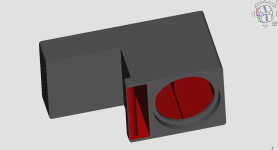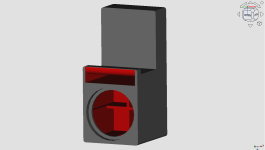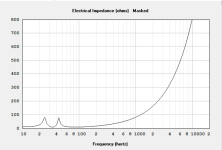A set of concept subwoofer cabs to trail a few drivers and choose a system for my mini DJ rig which I am calling the VolcanoSS or Volcano Sound System
It should be noted that the low volume cab sizes as drawn are designed for Low Vas/high Xmax drivers/very high power type of drivers such as the DS18 ZXI12.4d and ZR12.4D. The cab concepts will explore if drivers that can usually be heard from a street away can be ported to domestic and live use. This cab volume is easily increased for use with regular drivers
Build is using any stiff machinable material or combination off. Walls are designed to use 'thickness for stiffness' and at minimum MDF for pro or XPS for domestic duty and PVC foam for super heavy duty. MDF can be painted or veneered, but best performance and durability results are with an FRP sandwich. This will remove any remaining flex in the MDF appropriate to super sub duty
Driver location keeps the roll surrounds out of the main air volume, and the air cupped by the cone will add to the main air volume. A FreeCAD macro is used to determine the exact box material volume and then cavities are created, and the macro shows the new material volume. The difference of the two is the chamber air volume. The model takes the air volume within the driver cutout area and loss due to braces into account using this process
A small desktop CNC is required to build up the former in areas thicker than the panels and the tricky bits, but the cab can also be done using kerfing and knowing use of hand tools
The design can be reproduced in any manner or for any purpose. There is no IP concerns but keeping the VolcanoSS name is desired. This is just a design concept and can change
Volcano TLS
First up is the Volcano TLS, a sealed design concept targeting heat management. The driver is fitted reversed so that the motor assembly is in free air. It can be configured for any driver size, and cab volume is adjusted by changing the height of the upper and lower secondary air volumes. Both secondary volumes aren't required to be used at the same time or at all
The upper and lower chambers can also be closed off to use as an electronics bay. Or another chamber slice can be added to the cab for such use. A cavity or pod attachment can be done to the rear panel for terminals or electronics
The large blank face can take a fabric print sock or Plexiglass window. Mesh from a very large strainer can be modified to fit over the back of the driver. A rim for the mesh can be machined or printed. Alternatively, a fabric sock can be fitted over the whole speaker and recommended easy method
A second unit can be built on the other side of the face for a dual opposed setup
As drawn, the model is for a DS18 ZXI12.4D vs DS18 ZR12.4D trials, but the model can be adjusted to any driver and internal volume
Model specs (variable)
Internal air volume 19L
Width 360mm, height 540mm, depth 332mm
Wall thickness 32mm
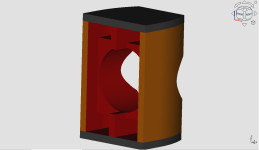
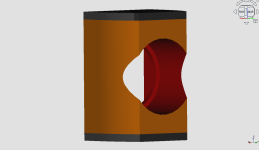
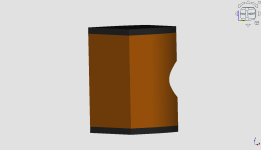
Volcano Kiss
Another sealed design concept with heat management for a conventionally mounted driver. The long side panels are 3mm alloy plate to couple internal air to the room for heat dissipation. An alloy heat collector shrouds the magnet and couples to the internal 3mm alloy plate rib. This plate is spaced out from the back panel using battens
The back of the magnet also couples to this plate for heat transfer as well. The plate has a hole that the pole vent fires through and, with the battens acting as standoffs, couples back into the cab air volume. A lock can be added to the top surface of the shroud to secure the magnet if desired
This alloy rib runs across the cab and couples with the alloy side walls. Why alloy side walls?
This is a fairly flat cab, two can be brought together for dual opposed. The back is deliberately kept clean to allow this
As drawn, the model is specifically tailored for a DS18 ZXI12.4D, but the model can be adjusted to any driver and internal volume. Volume is changed by changing height
The third pic is only the alloy structure. Let's call it a 'TF radiator'. Last pic shows dual opposed
Model specs (variable)
Internal air volume 24L (driver is 4L)
Width 360mm, height 450mm, depth 248mm
Brown = wood, red = internal wood, grey = alloy
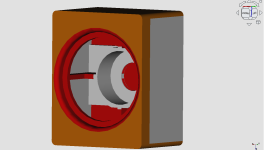
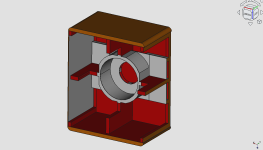
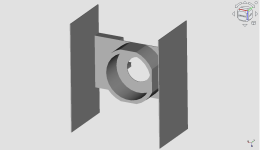
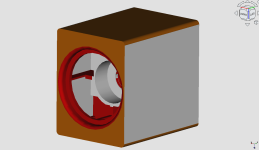
Volcano TLAmp1 and TLAmp2
Will be building this one to break the driver in and test the small Sd proof of concept thingy for the pro mobile subs. This folds such to fit in the car but also, if it works well, will form the basis for the potent instrument amp. Preferred over the BR due to managing the pipe resonances better, tuning the pipes in HR as a TL. Full story here
https://www.diyaudio.com/community/...fer-cabs-design-and-build.415232/post-7745529
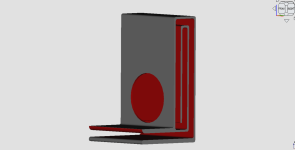
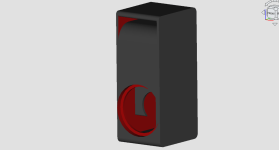
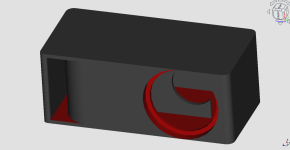
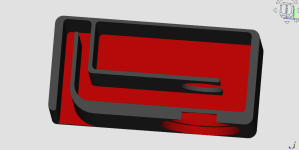
It should be noted that the low volume cab sizes as drawn are designed for Low Vas/high Xmax drivers/very high power type of drivers such as the DS18 ZXI12.4d and ZR12.4D. The cab concepts will explore if drivers that can usually be heard from a street away can be ported to domestic and live use. This cab volume is easily increased for use with regular drivers
Build is using any stiff machinable material or combination off. Walls are designed to use 'thickness for stiffness' and at minimum MDF for pro or XPS for domestic duty and PVC foam for super heavy duty. MDF can be painted or veneered, but best performance and durability results are with an FRP sandwich. This will remove any remaining flex in the MDF appropriate to super sub duty
Driver location keeps the roll surrounds out of the main air volume, and the air cupped by the cone will add to the main air volume. A FreeCAD macro is used to determine the exact box material volume and then cavities are created, and the macro shows the new material volume. The difference of the two is the chamber air volume. The model takes the air volume within the driver cutout area and loss due to braces into account using this process
A small desktop CNC is required to build up the former in areas thicker than the panels and the tricky bits, but the cab can also be done using kerfing and knowing use of hand tools
The design can be reproduced in any manner or for any purpose. There is no IP concerns but keeping the VolcanoSS name is desired. This is just a design concept and can change
Volcano TLS
First up is the Volcano TLS, a sealed design concept targeting heat management. The driver is fitted reversed so that the motor assembly is in free air. It can be configured for any driver size, and cab volume is adjusted by changing the height of the upper and lower secondary air volumes. Both secondary volumes aren't required to be used at the same time or at all
The upper and lower chambers can also be closed off to use as an electronics bay. Or another chamber slice can be added to the cab for such use. A cavity or pod attachment can be done to the rear panel for terminals or electronics
The large blank face can take a fabric print sock or Plexiglass window. Mesh from a very large strainer can be modified to fit over the back of the driver. A rim for the mesh can be machined or printed. Alternatively, a fabric sock can be fitted over the whole speaker and recommended easy method
A second unit can be built on the other side of the face for a dual opposed setup
As drawn, the model is for a DS18 ZXI12.4D vs DS18 ZR12.4D trials, but the model can be adjusted to any driver and internal volume
Model specs (variable)
Internal air volume 19L
Width 360mm, height 540mm, depth 332mm
Wall thickness 32mm



Volcano Kiss
Another sealed design concept with heat management for a conventionally mounted driver. The long side panels are 3mm alloy plate to couple internal air to the room for heat dissipation. An alloy heat collector shrouds the magnet and couples to the internal 3mm alloy plate rib. This plate is spaced out from the back panel using battens
The back of the magnet also couples to this plate for heat transfer as well. The plate has a hole that the pole vent fires through and, with the battens acting as standoffs, couples back into the cab air volume. A lock can be added to the top surface of the shroud to secure the magnet if desired
This alloy rib runs across the cab and couples with the alloy side walls. Why alloy side walls?
This is a fairly flat cab, two can be brought together for dual opposed. The back is deliberately kept clean to allow this
As drawn, the model is specifically tailored for a DS18 ZXI12.4D, but the model can be adjusted to any driver and internal volume. Volume is changed by changing height
The third pic is only the alloy structure. Let's call it a 'TF radiator'. Last pic shows dual opposed
Model specs (variable)
Internal air volume 24L (driver is 4L)
Width 360mm, height 450mm, depth 248mm
Brown = wood, red = internal wood, grey = alloy




Volcano TLAmp1 and TLAmp2
Will be building this one to break the driver in and test the small Sd proof of concept thingy for the pro mobile subs. This folds such to fit in the car but also, if it works well, will form the basis for the potent instrument amp. Preferred over the BR due to managing the pipe resonances better, tuning the pipes in HR as a TL. Full story here
https://www.diyaudio.com/community/...fer-cabs-design-and-build.415232/post-7745529




Attachments
Last edited:
There's a Volcano speaker company in the US, so maybe not the best name to latch onto.Volcano
Nothing came up in google search except for some JBL knockoffs from something called Volkano. There is no prior web presence, but thanks for the pickup. Its now VolcanoSS..... Volcano Sound System. Which is the name of a sound system, as in Randy is my nameThere's a Volcano speaker company in the US, so maybe not the best name to latch onto.
@AllenB @planet10 Guys, please amend the word Volcano in the tittle to VolcanoSS. Thank you
Volcano Audio Products is the one I was thinking of that's current. Volcano was a car audio driver brand years ago, but it seems they're mostly doing pro audio services now.
https://www.facebook.com/VolcanoAudioProducts/
https://www.facebook.com/VolcanoAudioProducts/
TLS, a sealed design
TLS often, most often, means Transmission Line System
dave
The driver is fitted reversed so that the motor assembly is in free air.
So you get the “benefit”of all the extra noisefrom the back of the driver?
Internal air volume 19L
Unusually small for a subwoofer.
dave
Another order of magnitude of volume and it's getting there... 😉Unusually small for a subwoofer.
Exactly right, but it can also be steered towards "transmission line, sealed". If you take a closer look at the segments, they are configured as three segments that can either be no taper, taper widening away from the driver or narrowing away from the driver. What makes it step away from traditional sealed box is that a pipe, especially one that can be tapered, can also be selectively dampened It's a line with the end closed offTLS often, most often, means Transmission Line System
dave
Next will show the same box without the segmenting. Much simpler to build but without the ability to dampen over a specific length due to not having a pipe system
Dave, I ran a JLAudio 15W3 reversed on a flat cab covering the whole trunk floor in a Holden Adventra LX8 wagon for 5yrs followed by a15" Earthquake with 35mm Xmax, both taking turns off the same JLAudio 1000wrms amp over the years. Never noticed any such noises from the driver. Can you give some examples of 12" drivers prone to such artefacts. I might be worth listing those as unsuitable. This cab is for situations where driver heat disposal takes priority. This is often when sheer SPL takes precedence and driver suspension noise is drowned outSo you get the “benefit”of all the extra noisefrom the back of the driver?
The LX8 was the premium executive class interior and awesome NVH dampening. That range of car subs are built extremely well. There are also a lot of subs where the driver is reversed and tapping the port exit wall
The next cab concept will also have heat disposal but with a conventionally oriented driver. For quieter listening areas. Just putting the finishing touches on that one

It is, but it is for the increasingly common low Vas drivers. Maybe you missed the mention that the volume is easily variable?Unusually small for a subwoofer.
The Volcano TLS model as drawn is for a high excursion, high power ZXI12.4D driver that I am personally running. I mention in the intro that the cab volume is increased by increasing secondary chamber heights, in other words increasing the pipe length. The volume in front from the driver corresponds to TC or throat chamber in Hornresp. Its a two segment pipe with the driver offset between the two. At 20L the pipe isnt very apparant but the cab can also take higher Vas drivers which will increase pipe length and becomes more apparant
Please explain?Another order of magnitude of volume and it's getting there... 😉
Exactly right, but it can also be steered towards "transmission line, sealed".
A sealed half-wave TL (sealed) would need to be much-much larger.
dave
What happens if you put that 12” driver with a vas of 20 liters in a 20 hz qw pipe big enough to even fit the chassis? It’s a long skinny straw connected to a brief chamber?Please explain?
it doesn’t really make much bass?
I take it that you guys are not familiar with the car SQ and SPL comps? There are some who prefer to bring these inside over regular home hi-fi due to crazy headroom and extension out of a tiny box. Have a look at the pinnacle of such thoughts linked below!!!
Please explain why this works? And the resistance towards some such DIY beasities? I find this prevailing negative attitude remarkable. What happened to ''''wooo let's see what this baby can do" attitude that this forum was all about?
https://stereo-magazine.com/review/jl-audio-gotham-v2-review
How many have heard the Gotham at full throttle? The dual opposed VolcanoSS TLS has the non-opposed dual driver Gotham in its DIY sights and in the 4Kw class
Good time to start adding to the usual and common high Vas/lower power driver based domestic use designs to stay relevant with the shrinking homes. The VolcanoSS are free for anyone to reproduce and take beyond concept
Booger
The car SQ comps are mostly sealed subs out of such small cabs and such massive drivers. But that is not the type of sound that I like. I prefer the sound of the port output very much in conjunction with direct driver output. I'll either build this TLS or the TL to break the driver in the car for a week
Please explain why this works? And the resistance towards some such DIY beasities? I find this prevailing negative attitude remarkable. What happened to ''''wooo let's see what this baby can do" attitude that this forum was all about?
https://stereo-magazine.com/review/jl-audio-gotham-v2-review
How many have heard the Gotham at full throttle? The dual opposed VolcanoSS TLS has the non-opposed dual driver Gotham in its DIY sights and in the 4Kw class
Good time to start adding to the usual and common high Vas/lower power driver based domestic use designs to stay relevant with the shrinking homes. The VolcanoSS are free for anyone to reproduce and take beyond concept
Booger
The car SQ comps are mostly sealed subs out of such small cabs and such massive drivers. But that is not the type of sound that I like. I prefer the sound of the port output very much in conjunction with direct driver output. I'll either build this TLS or the TL to break the driver in the car for a week
I think Your ported boxes are all too small(your 12” step tapered TL in the other thread had a vent exit of 100cm2) to make any deep bass instead of windy/chuffing sounds?
Yes, this must be trialled to see how the chuffing audible levels change with SPL. We fortunate that the box doesn’t realise that it’s too small, maybe we can fool it!I think Your ported boxes are all too small(your 12” step tapered TL in the other thread had a vent exit of 100cm2) to make any deep bass instead of windy/chuffing sounds?
Original post edited to introduce the second sealed design concept. Also, would like to acknowledge the education freely shared by guys like @GM and @weltersys for trying to help understand and learn acoustic design issues as well as understand how to correctly use WinISD and Hornresp. Guys, these will be the test boxes to trial all those prior discussions
Up next, the Volcano TLine. I do enjoy the sound of a ported system, so this TL looks like the best candidate to break the drivers in. This is going to be an extremely basic TL with some protection for a reversed driver. The design is for a workbench subwoofer
@Booger weldz. Hey man, this TL coming up next is the undersized Sd one to try with the super low Vas driver
Up next, the Volcano TLine. I do enjoy the sound of a ported system, so this TL looks like the best candidate to break the drivers in. This is going to be an extremely basic TL with some protection for a reversed driver. The design is for a workbench subwoofer
@Booger weldz. Hey man, this TL coming up next is the undersized Sd one to try with the super low Vas driver
Last edited:
That a 19l enclosure is not, and can never be, a 'subwoofer' having any worthwhile output. The extra order of magnitude makes it 190l - a much more realistically sized subwoofer!Please explain?
You are in for a treat, we are going to squeeze that even further!That a 19l enclosure is not, and can never be, a 'subwoofer' having any worthwhile output. The extra order of magnitude makes it 190l - a much more realistically sized subwoofer!
I thought this was a sub for a DJ rig? 19 liters sounds like 2.1 channel computer sub territory...are we about to break physics?!
Here’s the original ‘tapped pipe’ plans. I think it’ll work?@Booger weldz. Hey man, this TL coming up next is the undersized Sd one to try with the super low Vas driver
Attachments
- Home
- Loudspeakers
- Subwoofers
- Volcano Subwoofer Cabs, design and build
